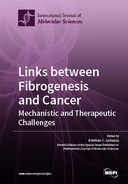Explore

Links between Fibrogenesis and Cancer
Esteban C. Gabazza
2019
0 Ungluers have
Faved this Work
Login to Fave
Tissue fibrosis may occur for unknown causes or be the consequence of many pathological conditions including chronic inflammatory or infectious diseases, autoimmune disorders, graft rejection, or malignancy. On the other hand, malignant tumors have been identified in fibrotic tissues decades ago, and now accumulating evidence suggests that fibrotic lesions enhance the risk of cancer in several organs such as liver, lungs, and breast. Disruption of an organ parenchymal cells and of its normal structural scaffold during tissue fibrogenesis appears to induce loss of cell polarity, promoting uncontrolled cell proliferation that may eventually lead to cancer development. Many cellular and molecular abnormalities including aberrant expression of microRNAs, genetic and epigenetic alterations, evasion or delayed apoptosis, unregulated intracellular signal pathways, and dysregulation or defective intercellular communications have been proposed to explain this link between fibrogenesis and carcinogenesis. However, the precise mechanisms of this fibrosis-to-cancer transition remain unclear. This book presents a collection of reviews and original articles summarizing recent advances in understanding the molecular mechanisms of cancer development in fibrotic organs.
This book is included in DOAB.
Why read this book? Have your say.
You must be logged in to comment.
Rights Information
Are you the author or publisher of this work? If so, you can claim it as yours by registering as an Unglue.it rights holder.Downloads
This work has been downloaded 266 times via unglue.it ebook links.
- 104 - pdf (CC BY-NC-ND) at Unglue.it.
Keywords
- acute lung injury
- Anaplastic lymphoma kinase
- Angiogenesis
- antitumor efficacy
- Apoptosis
- bleomycin
- Breast cancer
- butylidenephthalide
- Cancer
- cancer-associated fibroblasts
- cancer-associated fibroblasts (CAFs)
- carcinogenesis
- cirrhosis
- clinical symptoms
- common pathways
- crizotinib
- cystic formation
- cytokine
- Cytokines
- DHA
- Diagnosis
- EMT
- Erk1/2
- Extracellular matrix
- Fibrosis
- genetic instability
- GPR120
- GPR40
- growth factor
- HBV
- HCV
- Hepatic Stellate Cells
- hepatic stellate cells (HSCs)
- hepatocellular carcinoma
- hepatocellular carcinoma (HCC)
- hepatocytes
- heterogeneity
- Hippo pathway
- idiopathic pulmonary fibrosis
- idiopathic pulmonary fibrosis (IPF)
- immunohistochemistry
- Inflammation
- interstitial fluid pressure
- leiomyoma
- leiomyosarcoma
- lipopolysaccharide
- lncRNA
- lung cancer
- lung cancer (LC)
- Märker
- Mechanotransduction
- medicine
- metabolic reprogramming
- metastasis
- miRNA
- myometrium
- n/a
- Nanoparticles
- non-alcoholic steatohepatitis
- non-small cell lung cancer (NSCLC)
- omega-3 fatty acid
- Pathogenesis
- Pathology
- Pathophysiology
- protein S
- pulmonary fibrosis
- Reactive Oxygen Species
- Regeneration
- renal injury
- signal pathway
- SMAD
- smooth muscle tumor of uncertain malignant potential
- SOX2
- SREBP-1
- targeted therapy
- TAZ
- TGF-?
- Therapy
- transforming growth factor-?
- tumor
- Tumor microenvironment
- tumor necrosis factor ?
- tumor stiffness
- type I collagen
- uterine fibroid
- Wnt
- YAP
Links
DOI: 10.3390/books978-3-03921-707-6Editions


